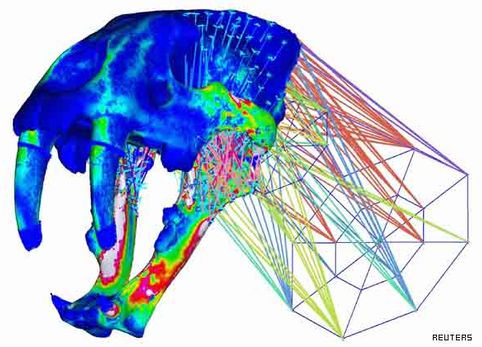Washington: Scientists have discovered two fearsome species of saber-toothed cats which they believe might once have stalked the early humans.
However, the feline predators might also have proven to be a boon to our ancient relatives who could have scavenged the meat they left behind, said researchers from University of Poitiers in France.
According to the researchers, the new fossils were uncovered in the vast, flat, windy Djurab desert in northern Chad in central Africa.

© Reuters
This is the place where the earliest member of the human lineage - the about 7-million-year-old human-like, chimp-like
Sahelanthropus tchadensis, nicknamed "Toumai" -- was discovered.
Toumai was discovered alongside the bones of a wide variety of animals -- crocodiles, three-toed horses, fish, monkeys, hippos, aardvarks, turtles, rodents, giraffes, snakes, antelopes and many others.
According to Louis de Bonis, a paleoanthropologist at University of Poitiers, the area was once the shore of a lake, generally forested close to the waters with savannah-like areas too far away, LiveScience reported.
The desert, he recalled, also has snakes and scorpions that researchers must look out for.
Scientists had known one giant species of saber-toothed cat, called
Machairodus kabir, also lived there and was the largest predator of that area. Weighing between 350 and 490kg, the giant feline predators outweighed the largest living cat, the tiger, which can reach up to 660 pounds or 300 kg.
Now, researchers have unearthed two more saber-toothed cat species there -- a roughly lion-sized member of the genus
Lokotunjailurus, or scimitar-toothed cats, and a leopard-sized member of the genus
Megantereon, or dirk-toothed cats.
It's surprising to find three different kinds of saber-toothed cats in one area, de Bonis said, meaning that prey must have been numerous a "lost paradise for carnivores", he told LiveScience.
Hominids such as Toumai could have been prey for these predators, he added.
Still, another possibility is that antelopes and other large victims these saber-toothed cats brought down could have left behind large amounts of flesh to feed our distant relatives, de Bonis suggested.
These fossils also revealed interesting clues about the origin and behaviour of saber-toothed cats. For instance,
Lokotunjailurus was only known in East Africa, meaning that scimitar-toothed cats are now known found at least 1,550 miles (2,500km) from their original known locale.
Also, Megantereon was thought to perhaps originate in North America and later dispersed to the Old World, but this ancient specimen suggests it originated in the Old World and later migrated to the New World.
The findings are published online in the journal
Comptes Rendus Palevol.

Reader Comments
to our Newsletter